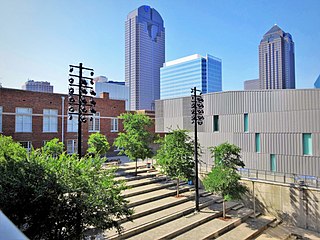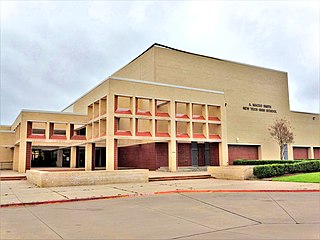History
This section needs additional citations for verification .(September 2011) (Learn how and when to remove this template message) |
Wilmer-Hutchins Independent School District was established in 1927 as a consolidation of four smaller school districts. Wilmer-Hutchins High School was established in 1928. At the time it had one elementary school for black students that had been built for $2,000, and that school had one teacher. At one point district officials cleaned the second floor of the black school and converted it into Wilmer-Hutchins Colored High School. Around 1939, Wilmer-Hutchins Colored High School burned down in a fire. After that occurred, children were bused to Dallas ISD schools such as Booker T. Washington High School and Lincoln High School. Black elementary students attended classes at Little Flock Baptist Church until a new elementary school named Morney Elementary School was opened. [3]
In September 1954, more than 100 African-American students and parents went into Linfield Elementary School, then an all-White WHISD school. They were tired of the district's periodic closing of Melissa Pierce School, an all-Black school, so students would pick crops. The district turned the students away. [4]
In 1958, WHISD had 1,746 White students and 577 African-American students. The number of African-American students increased rapidly over the next decade as the United States government established housing policies that concentrated many African-American families in the northern part of the district, which was in Dallas, while the cities of Hutchins and Wilmer remained majority white. [4] The district, still clinging to its policy of segregation, spent millions of dollars building new schools for black students - Bishop Heights Elementary School, Milton K. Curry Junior High School and John F. Kennedy High School were all opened in the early 1960s. The more rural southern portion of the district remained predominantly white - Linfield, Alta Mesa, Wilmer and Hutchins Elementary Schools were reserved for white students, as was Wilmer-Hutchins Junior High and High School.[ citation needed ] In February 1970, WHISD was forced to implement desegregation busing. [4]
The mayor of Hutchins, Don Lucky, formed a group of followers and hijacked Hutchins Elementary School for a period. Two out of three White people in WHISD moved away from the district in the early 1970s. [4] WHISD became predominately economically poor and African-American; WHISD became controlled by African-Americans. [5]
In 1999, the school district had 3,651 students. [6] In April 2003 it had 3,060 students and had gained 35 students from the start of the year. [7] By 2004 it had about 2,900 students. [6] It was the only Dallas–Fort Worth metroplex school district to have lost population between 1999 and 2004. Many WHISD parents left the district, putting their children in Dallas Independent School District schools or charter schools. [8]
Performance
Throughout its existence, the district was historically recognized as one of the poorest-performing school districts in Texas, in terms of both student test scores and managerial oversight. The Texas Education Agency (TEA) had, on several occasions, appointed monitors to oversee the district, with no long-term success. [9] This led to the decrease of the student body in the district. The district shrank by more than a third of its student size in the 2000s (decade), and, by the 2000s (decade), the district's boundaries had more charter school students than any other district in the state of Texas.[ citation needed ]
In the 1970s, the State of Texas threatened to revoke the district's accreditation. Due to misuse of district funds and fraudulent elections in the 1980s the Texas Education Agency threatened to close the district. In the 1990s, for two years the TEA took over operations of WHISD. [10]
Around 1996, according to the district's accounts, 600 students in the WHISD attendance zone attended school in other school districts, such as Dallas ISD and Lancaster ISD, by using false addresses or addresses of relatives, since many of the families in the WHISD attendance zone did not make enough money to enroll their children in private school. [5] Due to hastiness and lack of following procedure when firing employees, the district in 1996 had a legal budget of $366,583 ($585614.98 when adjusted for inflation), amounting to about $114 ($182.11 when adjusted for inflation) per student. This is compared to the Plano Independent School District's legal spending of $161,598 ($258152.2 when adjusted for inflation), about $4 ($6.39 when adjusted for inflation) per student, and the Dallas Independent School District's legal budget of about $900,000 ($1437746.66 when adjusted for inflation), about $6 ($9.58 when adjusted for inflation) per student. [11]
In 2004, the district closed Wilmer-Hutchins Performing Arts High School, A.L. Morney Learning Center, and Hutchins Academic Elementary School. The board also voted to eliminate the district's police department and fire the police chief, Cedric Davis. [8] By 2005, the district's buildings were in poor shape. Large trees grew out of the bleachers of the Wilmer-Hutchins ISD football field. [9] Wilmer-Hutchins High School failed fire inspections twice in a row. [12]
Morgan Smith of the Texas Tribune said "When the state closed Wilmer-Hutchins ISD six years ago, the district was like the region’s unwanted stepchild — few of the neighboring districts wanted to absorb students from its low-performing schools." [10]
Dianna Wray of the Houston Press stated that WHISD "was almost a mirror image of [ North Forest Independent School District ] in both demographics and history". [13]
Closure
After a series of investigative stories in The Dallas Morning News found evidence of cheating on the Texas Assessment of Knowledge and Skills in Wilmer-Hutchins, the Texas Education Agency (TEA) began an investigation into the findings. That investigation found sufficient evidence of educator-led cheating for TEA to retroactively declare the school district "academically unacceptable" (the lowest possible ranking). The retroactive ranking was the second consecutive "academically unacceptable" rating, which gave the TEA authority to close WHISD and transfer its students to another school district. After WHISD voters overwhelmingly defeated a proposal to increase the property tax rate (many citing the district's shoddy recordkeeping), the TEA elected not to attempt yet another monitoring effort, and instead ordered the district closed for the 2005–2006 school year. The Lancaster ISD was given first opportunity to absorb the district, but declined. [9] Instead, the Dallas Independent School District agreed to absorb WHISD. [14] The United States Department of Justice approved the closure on December 13, 2005. [15] The district held its final meeting on June 30, 2006. [16] Dallas ISD elected to close all of the Wilmer-Hutchins schools and sent students to existing Dallas schools. The entire senior class of Wilmer-Hutchins High School went on to South Oak Cliff High School. Other students were divided into several different schools. [17] Marlon Brooks, the principal of Wilmer-Hutchins High School as of 2011, said that some students had commutes of over one hour. [18] Some students were over 12 miles (19 km) away from their zoned schools. [19]
The Dallas Observer , an alternative newsweekly, argues that DISD agreed to absorb the district because of the significant tax revenue to be gained from the recently completed US$70 million Union Pacific Dallas Intermodal Terminal, which is located partly in the city of Wilmer and partly in the city of Hutchins, but wholly within the WHISD district boundaries. [9] [20]
After the closure of WHISD, property values in the district increased. [21]










